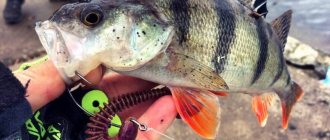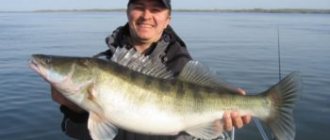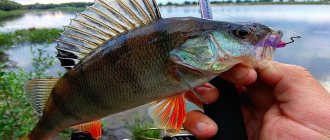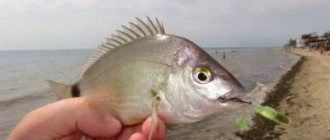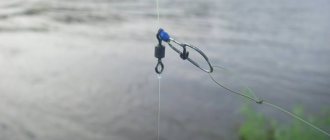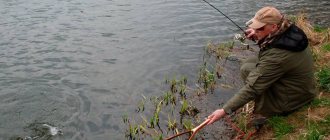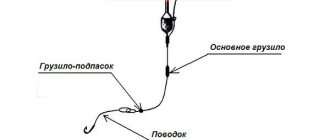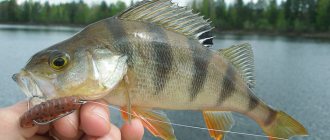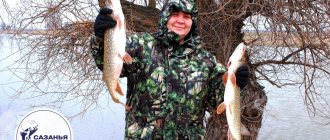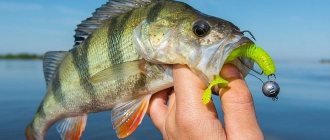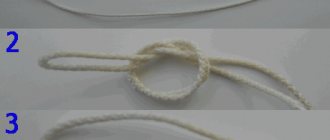Content
- Retractable leash for perch, installation and fishing methods
- How to properly tie a leash to the main line
- Methods for installing a diverter leash
- Choosing a sinker for a lead
- Choosing a hook for the outlet
- Leash line (fluorocarbon)
- The best baits for the Twister diverting leash
- Slug or “slug”, “worm”
- Spinner
- Other baits
There are a large number of different methods and types of equipment in spinning fishing. Some constantly progress and improve, others go out of fashion, cannot withstand competition and are forgotten. But today we will talk about editing, which was used by our grandfathers. It is so good to this day that it is recommended for beginners to master first. Every self-respecting spinning player should master it perfectly.
Choosing a fishing spot
If you are going to catch perch on a retractable leash, keep in mind that perch loves fresh water. When fishing on a pond, go to its beginning, where the river flows into this very pond. This is a guaranteed spot with plenty of bass. When fishing on a river, choose a steep bank rather than a flat one. Here the depths of 2-5 meters are much closer, where the perch stands.
When fishing on a reservoir, the same rule applies - choose a steep bank and try to cast as far as possible. Significant depth and the presence of depth differences are possible 50-70 meters from the shore, so an increased casting range and the use of sinkers of 14-18 g are quite justified.
Video about underwater filming of a perch and its reaction to a retractable leash:
Here you can clearly see the action of the bait in the water on a lead rig.
Retractable leash for perch, installation and fishing methods
Fishing with a spinning rod is considered one of the most lethal methods of fishing. Especially if you are fishing for bass. The installation is so simple and catchy that it was banned in official competitions. But why shouldn’t ordinary amateur fishermen adopt it in order to more often return from fishing with their heads held high and a good catch?
Let's figure out why it attracts fish so much and how to choose the most successful installation among the many methods and equipment options.
Fishing technique + video
Fish the shore gradually moving to the side, casting every 10-20 meters. Make 2-3 casts in different directions, and then, if you don’t find any bites, move again.
- The ideal bait retrieval when fishing with a retractable leash is a stepped retrieve.
- You cast the rig to the maximum distance, or to the distance required for your fishing conditions.
- Close the line guide of the reel to stop the line from flowing from the spool.
- Place the spinning rod slightly to the side and keep the line taut while looking at the tip of the rod.
- As soon as the line slacks, it means the bait is on the bottom, it’s time to start reeling.
- Stepped retrieving involves 1-4 turns of the reel handle and a pause until the load falls to the bottom again, and then again making those same 1-4 turns.
We recommend watching a video about catching perch in practice:
We recommend experimenting with the number of coil revolutions, speed of rotation, and pause duration. You should start with two quick turns. Make several casts using only this type of wiring and if it doesn’t work, try increasing the number of revolutions, reducing the speed of revolutions, and making longer pauses. That's all the practice is.
How to properly tie a leash to the main line
Let's talk about how to tie the lead leash to the main line so that it does not get tangled. “Tap-off”, also called “Moscow equipment” , refers to spaced types of installation, i.e. The sinker and hook are on a separate leash, which allows the bait to play freely and float in the water column. Probably thanks to this, it becomes a leader in terms of catchability, surpassing the classic jig and even the Carolina rig in catching perch.
This method of fishing does not require fine selection of the weight of the sinker; it is enough to simply control the bottom after casting. You can use a greater sinker weight than when fishing with a jig, thereby increasing the casting distance of the bait, which is an undeniable advantage when fishing from the shore.
For new anglers, this is generally the best way to consistently catch fish, so I would recommend mastering this method of rigging it first.
So, how not to get confused among the many installation methods. Evolution does not stand still; fishermen are looking for the most successful ways to tie a leash and sinker to minimize entanglement. This video, in my opinion, shows one of the latest and most successful methods that fishermen have come to.
But I would recommend trying several installation methods to decide for yourself which one is suitable for your fishing conditions. Ease of manufacture is not an unimportant factor in this choice.
Maybe you know of an even more successful installation? Please advise in the comments.
Lures
Twisters are the choice of the vast majority of spinning anglers using Moscow equipment. The fact is that thanks to the numerous sizes, colors, and flavors of such rubber, you can very well adapt to the weather, fishing depth, and fish activity.
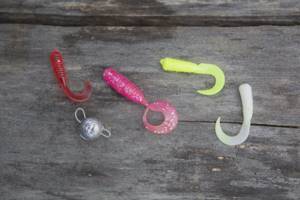
The second advantage of the twister is its naturalness in the water with step-by-step wiring of the outlet leash. After the bait has fallen to the bottom, you have the opportunity to wait a little longer until the twister slowly sinks, at which point the fish can also attack the bait. Other baits that have a lot of weight sink very quickly and do not show decent performance.
Wobblers are also used. Floating models and suspenders are suitable. The latter are more similar to a twister in terms of behavior in water during pauses.
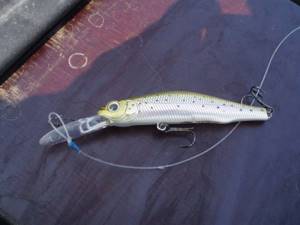
It is advisable not to use deeply buried models, but surface wobblers with minimal depth are ideal.
Spinners such as spinners, spinners, castmasters, and Devons are used much less frequently in lead rigs.

Fishing with a retractable leash in the current differs only in the use of a heavier sinker. Indeed, during wiring, we must very sensitively feel the movement of the equipment in the water column and its reaching the bottom.
Methods for installing a diverter leash
In this picture I have collected for you the most common rigging methods, each of them has its own pros and cons. Some of them will be less tangled, the other will be easier to make from the simplest materials at hand, without even using swivels. It’s better to try several options yourself to see which one is best for you.
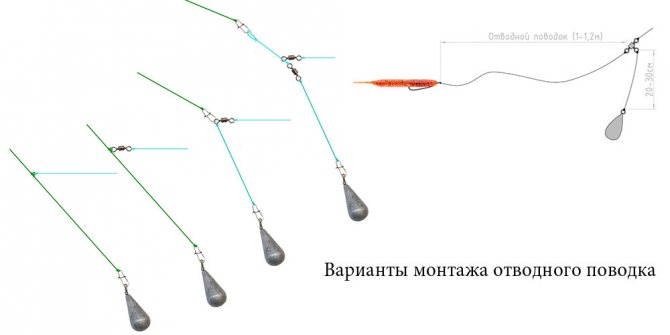
An important point regarding the casting technique of this tackle. To make the leash less tangled, you should slow down the cord a little at the end of the flight. On inertial coils, this happened automatically, because. at the end of the flight, the reel is braked with a finger, the leash moves forward by inertia and straightens out, which prevents it from becoming more entangled. On spinning reels, I also recommend slightly slowing down the braid at the very end of the flight, the equipment does not fall all in one heap, but also straightens out and lies down properly.
Choosing a sinker for a lead
Different types of sinkers are suitable for the outlet. Most often, sinkers with a swivel in the form of an elongated drop or “banana” are used. It is believed that they pass minor hooks better, stones and fishing line fray less, and their aerodynamics are quite good for long-distance casting.
But there are also those who like to use ball-shaped sinkers, which, when falling, hit the bottom harder and raise dirt, although this is controversial. But one thing is certain - such acoustic vibrations attract fish and this is another factor in the success of the retractable leash. For mountain rivers and places where the bottom is strewn with many stones, a Tyrolean stick is used. There is equipment with a “ballerina sinker”, but I will not dwell on these options in detail.
The weight of the sinker varies depending on the fishing conditions, depth and current. Usually this is 20-40 g, some overload is quite acceptable for better bottom control and long casting.
It is better to attach the load to a separate leash made of thick fishing line about 0.5-0.6 mm in diameter, because The braided cord quickly rubs against stones, underwater obstacles, edges, and shell rock, and this leads to frequent and unpleasant shootings. Some, especially earlier, even used nylon cords for this section of equipment and additionally protected the place where the load was tied with electrical tape.
Choosing equipment for fishing with a retractable leash
Sinkers
The weight of the load for the equipment is selected based on the fishing conditions. Therefore, the following factors must be taken into account:
- depth at the fishing site;
- casting distance;
- current power;
- wiring speed.
As a rule, fishermen use sinkers weighing from 5 to 25 grams, but in strong currents their weight can increase.
You can use sinkers of different shapes. So, on a clean bottom, where there are no piles of stones and abundant thickets of aquatic vegetation, ordinary round sinkers work well. In addition, they are quite long-range.
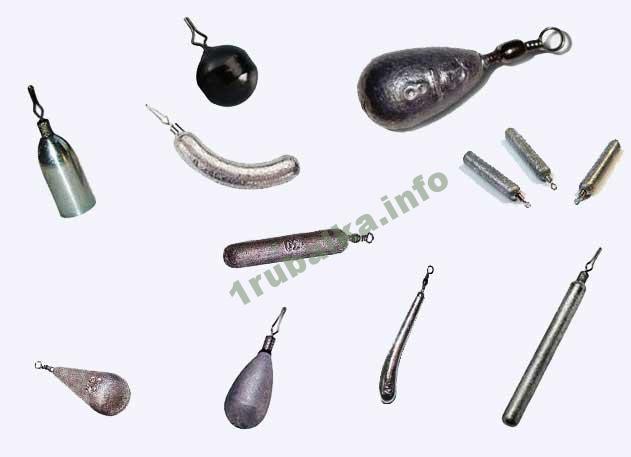
If you are fishing with a drop leader in strong areas, you can use a Tyrolean stick, banana-shaped weights and drop-shot weights. They pass through areas with snags well. Unfortunately, their range is poor, and a small cloud of turbidity is formed when they hit the bottom.
The most successful option would be to use pear-shaped sinkers in the rig. They have both good maneuverability and high range.
Hooks
Both regular and offset are used. Conventional ones are placed in places with a clean bottom, where there is no danger of snagging. Installation of an offset hook will be required where there are algae, snags and scattered stones. To catch pike perch on a retractable leash, it is necessary to use sharp and strong hooks, otherwise we will not be able to break through its powerful mouth, especially for low-quality offsets, which, when they encounter a strong bone, begin to depreciate and work idle.
Line for sinker and lead
The breaking load of the leader line should be less than the main one. True, for the fishing line on which the sinker is located, this is not so critical, since due to constant contact with the bottom, it loses its strength.
Therefore, in rocky areas and areas strewn with shell rock, ordinary wicker will not work for us. Here it is necessary to use high-quality monofilament, but fluorocarbon with a thickness of 0.26-0.35 mm is better. Some also use metal cables, but in this case, if the sinker is hooked, you will lose all the equipment.
Braid is also not suitable for a lead leash, as it is more susceptible to twisting and tangling.

It is better to use the same monofilament and fluorocarbon. In strong areas, a thin line will often break, but at the same time, the smaller its diameter, the more interesting the game of the bait. For perch, 0.16-0.2 mm monofilament or 0.2-0.24 mm fluorocarbon will be sufficient. When hunting for pike perch, leashes made of monofilament 0.21-0.24 mm or fluorocarbon 0.26-0.3 mm are used.
Fishing for pike with a retractable leash will be successful when using thick fluorocab with a diameter of 0.35-0.45 mm. Of course, its sharp teeth can bite through even such a thick leash, so fishermen use flexible titanium or Kevlar cables. Unfortunately, in this case the number of bites drops significantly.
In terms of length, it is recommended to use a bend of 130-150 cm, this is the optimal length. In cases where the fish does not want to attack the bait, it is necessary to work with its length, making it shorter or, on the contrary, increasing it.
In order to use long leads, you need an appropriate length of the rod; this is also important to take into account when installing the equipment.
Choosing a hook for the outlet
Which hook to equip the leash with depends on the fishing conditions and the bait used. Of course, if you fish in places where there is grass on the bottom and other hooks, then it is better to equip the leash with an offset hook, which is hidden in the body of the soft bait. You can call this a universal installation method.
But if you use this installation in relatively clean places, then it is quite suitable to equip the bait with a regular single hook with a long shank, or even use a small double hook.
You must choose the hook number based on the object being fished. The smallest sizes are suitable for catching sport perch. For striped humpbacks - choose size 3-4. If you suddenly decide to purposefully catch pike on a diverter, then do not forget to equip the leash with a string, or a thick “flure” 20-30 cm long and use the appropriate hooks. Select the hook that best suits the bait you are using.
Leash line (fluorocarbon)
To ensure that the leash itself gets tangled as little as possible and does not overlap, you should use the stiffest fishing lines. An even better option is a fluorocarbon , although it is more expensive than fishing line, but its use minimizes tangles. You can also use fluoro-coated fishing line; perhaps this will be the best option for you, but I still advise you to go with fluorocarbon. The length of the leash should vary from 80 cm to 1.5 meters. The longer the spinning rod and the cleaner the shore, the longer the leash can be set. And vice versa, when fishing from a boat together, keep the leash shorter. Its length affects the bite, especially when the fish is passive.
For amateur fishing, I recommend choosing a leash diameter of about 0.25-0.3 mm. Personally, I don’t see the point in using sophisticated equipment in this fishing method, because... The thinner the fishing line you use on the leash, the faster and more likely it will get tangled. And only with the weakest and most careful bite can you compromise. But in most cases this is not required.
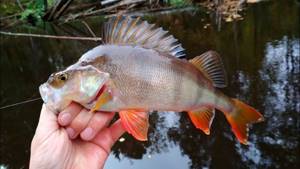
The best lures for a retractable leash
This is one of those types of equipment for which it is, in my opinion, not acceptable to use vibrating tails. On a long leash, a bait of this type does not stabilize, it begins to fall over, rotate, and play in a completely inappropriate manner. It is better to choose other, more suitable baits.
Twister
One of the most popular rubber bands that will play well and not fall over. I like to use long twisters with a small tail at the end. For pike fishing I prefer silicone with a double tail, but this is not for everybody. It is better to use edible rubber.
Slug or “slug”, “worm”
An artificial nozzle that is gaining popularity. This is a passive bait, so when using it, it is necessary to introduce more variety into the wiring. You should add animation yourself - twitching, jigs, changes in tempo - give free rein to your creativity. It is recommended to combine fishing with a “worm” with a heavy load, which will clearly knock on the bottom, additionally attracting fish.
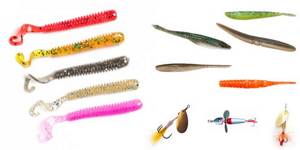
In addition to the usual installation, there is a technique - “wacky” , when the bait is put across the body, which gives it an interesting game. But we will not dwell in detail on its application; we will leave this for aesthetes and your independent creativity.
Spinner
The “pinwheels” come to the fore when the first fry appear. Unloaded “perch spinners” should be used. They perfectly resemble a newly hatched fry, and their petal creates vibrations in the water, attracting fish from a great distance. Sometimes they are additionally equipped with a “turbine”, which also has its effect. In addition to perch, ide, small grass pike and even large roach readily take it.
Other baits
As an option for creativity, you can try fishing with a Moscow rig using foam rubber fish, artificial flies, streamers or even a wobbler. If you have had successful experience of fishing with non-standard baits, tell us about it in the comments. What else can be successfully used for “diversion”?
Retractable leash for catching perch
Perch is not a very large fish, so the tackle should be more sensitive. The bite will be well transmitted to the rod when sliding the diverter float:
- A swivel is attached to the main cord or fishing line.
- The end of the main line is tied to the second swivel.
- A thinner fishing line is passed through the free “ear” of the sliding swivel, onto which a sinker weighing from 3 to 10 grams is also placed. The ends of the fishing line are tied together. The weight should slide easily along the resulting loop.
- A leash made of fluorocarbon fishing line 35-70 mm long and 0.2 to 0.4 mm thick is tied to the free “ear” of the second swivel. A silicone bait with an offset hook is attached to the other end of the leash. If fishing takes place in the current, then, to sink the bait to the bottom, the hook can be weighted with a pellet.
Adviсe:
- In order not to lose the entire tackle when hooked, the hook should be 3 kg, the main cord should be 5 kg, and the leash should be 4 kg.
- Silicone bait that imitates crayfish has proven itself well. Perch actively reacts to the movement of numerous limbs in the water.
- The bait for river perch should be larger than for lake perch, since the predator grows smaller in stagnant water.
- A rod with a glued tip rather than a solid one will show a good bite.
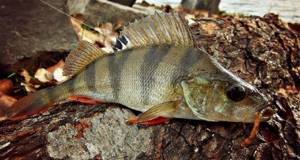
Retractable leash for pike and zander
Usually, perch is purposefully caught using the Moscow rig, but pike, pike perch and ide also bite as by-catch. By the way, for the latter, this is a very successful equipment option. Small rotating spoons are exactly what will not leave this predatory representative of cyprinids indifferent.
When fishing for pike, be sure to use a steel or thick fluorocarbon leader. The toothy one loves the movement of the bait in the horizontal plane, so this is a very successful equipment for catching grass. When hunting for larger pike, I prefer classic jig wiring and the use of large vibrating tails.
Small pike perch are also not bad at catching on the “divert line”. But large individuals prefer more expressive vertical, falling movements of the bait, therefore, for hunting for trophy pike perch, the use of a retractable leash seems inappropriate to me.
